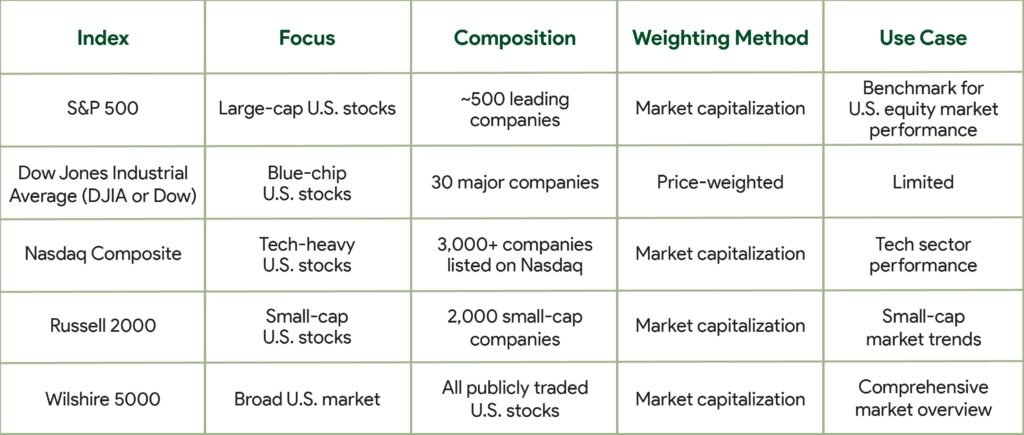
Every day in my office, the television is tuned into Bloomberg, broadcasting the latest financial news. Alongside the news is a rolling column of acronyms, flanked by red or green numbers, changing every twelve seconds. S&P 500, DOW, NASDAQ, RUSS 2K, TSX, FTSE, MSCI EAFE, STOXX 50, NIFTY 50. There is no shortage of these jumbles of letters and numbers. What those jumbles represent are investment indexes.
What is an Investment Index?
An investment index measures and tracks the performance of a group of assets—typically stocks, bonds, or other securities. These indexes are designed to represent a specific segment of the financial market, such as large-cap U.S. companies or small-cap growth stocks. By aggregating the prices of selected securities, an index provides a snapshot of market trends and investor sentiment. The red or green numbers tell us whether they are moving up or down.
Investment indexes are essential tools in the world of finance, serving as benchmarks for evaluating the performance of various asset classes and guiding both passive and active investment strategies. This article explores what investment indexes are, how they work, and how major indexes compare. As a bonus, we’ll touch on why the Dow Jones Industrial Average is a flawed measure of the market and rarely used by investment professionals.
How Do We Use Investment Indexes?
Investment indexes are widely used for:
• Measurement: Tracking the change in various security prices over a period of time.
• Benchmarking: Comparing the performance of individual investments or portfolios.
• Passive investing: Replicating the performance of an index through index funds or ETFs. This strategy is used when trying to attain index performance rather than outperform. It is worth noting that you cannot invest directly in an index.
• Market analysis: Gauging the health of specific sectors or the broader economy.
Major Investment Indexes
Here’s a comparison of some of the most prominent U.S. stock market indexes:

Comparing and Contrasting Indexes
Scope: In the U.S., the S&P 500 and DJIA focus on large-cap stocks, while the Russell 2000 targets small-cap companies. The Wilshire 5000 offers the broadest market coverage for U.S. stocks.
Around the globe, there are indexes that cover world, global, foreign, and emerging markets, along with country or region specific market sectors such as Japan, India, Asia Pacific, or Europe, just to name a few.
Weighting: Most indexes use market capitalization, meaning larger companies have more influence. The Dow is unique in using price weighting, which can skew its representation.
Sector Exposure: Some indexes follow specific market sectors. The Nasdaq Composite is heavily weighted towards technology, making it more volatile but also more reflective of innovative trends.
Investment Strategy: Indexes like the S&P 500 are popular for passive investing due to their broad exposure and historical performance.
Why Indexes Matter
Indexes are more than just numbers—they are foundational to modern investing.
They help investors:
• Track market and account performance
• Allocate assets strategically
• Evaluate fund managers
• Reduce costs through passive strategies
How do Indexes Fall Short?
Indexes, when used correctly, can be highly beneficial. Benchmarking a portfolio made up of 60% stocks and 40% bonds against the Nasdaq, for instance, would not give an investor much insight. Trying to gauge how the U.S. economy is trending using the Nifty 50 index (which tracks 50 of the largest stocks in India) would also be less than helpful.
Several of my coworkers used to pop their heads in and marvel at the Dow being up several hundred points. Through intensive training, most have been cured of this bad habit. The Dow is useful in the fact that it has been around since late 1800’s and it gives investors a look at what the market was doing before, during, and after major historical events. The roll call of companies that previously and currently make up the index serves as a guidebook to the industrial and technological changes our country has gone through.
Where the Dow falls short is in its makeup and methods. It is comprised of 30 well-established American companies whose names you would probably recognize. This is a very small sample of the thousands of publicly traded companies in the U.S. This narrow selection makes it less representative of the broader market compared to other indexes such as the S&P 500 or Wilshire 5000. A committee is responsible for adding or removing companies, which introduces bias and subjectivity. Because of the small sample size of companies and selection criteria, the Dow can be skewed towards certain sectors while missing out on others. Historically, technology companies have been underrepresented in the Dow, which has been a major driver of modern economic growth.
Almost all indexes use market capitalization as a weighting method. Companies with larger market capitalization will have a higher weighting and will have more influence on the index. The Dow uses price weighting. This means companies with higher stock prices have a disproportionate impact on the index, regardless of their actual size or economic importance. For example, a $400 stock will influence the index much more than a $40 stock, even if the $40 stock represents a much larger company.
Investment indexes are indispensable tools in the financial world, offering a snapshot of market trends and guiding investment strategies. Whether you’re tracking the performance of large-cap stocks with the S&P 500 or gauging the health of the tech sector with the Nasdaq Composite, these indexes provide valuable insights that help investors make informed decisions. While each index has its unique characteristics and limitations, understanding their role and functionality can empower you to navigate the complexities of the market with confidence. As you continue to explore the world of investment indexes, remember that they are more than just numbers—they are the benchmarks that shape the landscape of modern investing.

